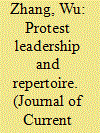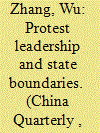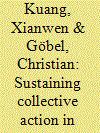| Srl | Item |
| 1 |
ID:
121257


|
|
|
|
|
| Publication |
2013.
|
| Summary/Abstract |
Based on detailed ethnographic fieldwork, this paper compares two cases of peasant protest against heavy taxes and fees in a
northern Hunan county in the 1990s. It argues that peasant protest did
not arise spontaneously. Rather, it erupted when leaders emerged who
used central policy documents on lowering peasant taxes and fees to
mobilise peasants. Protest leaders were articulate and public-spirited
peasants who had received political training from the local party-state.
Furthermore, the number of leaders, their education level, and their relationship with the local party-state explain why the repertoire and the
scope of the two protests varied. Protests led by less educated veteran
Communist Party cadres tended to be milder and smaller than those led
by better-educated peasants more distant from the local party-state. This
paper helps us to understand the process of peasant mobilisation in contemporary China and explains why peasant protest varies across cases.
|
|
|
|
|
|
|
|
|
|
|
|
|
|
|
|
| 2 |
ID:
139558


|
|
|
|
|
| Summary/Abstract |
How does protest spread in contemporary China? This paper analyses one case of cross-firm protest and two cases of cross-village protest in order to demonstrate a mechanism for protest diffusion, a topic rarely studied in the existing literature. It argues that central policies, protest leadership and a connective structure that links protest leaders and followers enable people with shared economic interests to protest together. Protests emerged when protest leaders, who were trained politically by the state and enjoyed moral standing in a small community, started popularizing policy documents among followers. Protest diffusion occurred when representatives from each participating unit coordinated with one another and coalesced around the core leaders, who decided tactics for the entire protest. The protestors, however, did not form coalitions across different administrative boundaries. Thus, protest leaders did play a decisive role in the spreading of a protest. However, the state also moulded and restricted the scale of the diffusion.
|
|
|
|
|
|
|
|
|
|
|
|
|
|
|
|
| 3 |
ID:
124890


|
|
|
|
|
| Publication |
2013.
|
| Summary/Abstract |
In recent years there has been a proliferation of scholarship on protests and other forms of collective action in China. Important insights have been gained into how conflicts between social groups and local governments begin, which strategies and instruments protesters apply, and under which circumstances protests are likely to succeed or fail. However, comparatively little is known about the mobilizing structures and how such collective action can be sustained over a long period of time, in some instances over several years. Such perseverance would be remarkable even in a democracy, but it is more so in an authoritarian system where the risks of participating in collective action are higher and the chances to succeed much smaller. This article compares the development of public protests in two research locations and identifies four factors instrumental to overcoming the formidable challenges of sustaining collective action in China: the continuing existence of substantial grievances; the re-activation of strong social ties; the presence of unifying frames; and an adaptive protest leadership. The comparison shows that the last factor is particularly crucial: while the two villages were similar in all other respects, leadership in village B was far more adaptive than in village A, which goes a long way towards explaining why collective action could be sustained twice as long in village B.
|
|
|
|
|
|
|
|
|
|
|
|
|
|
|
|